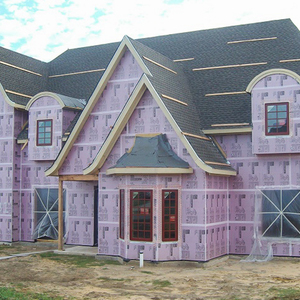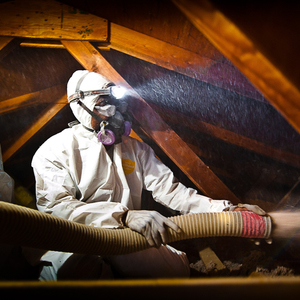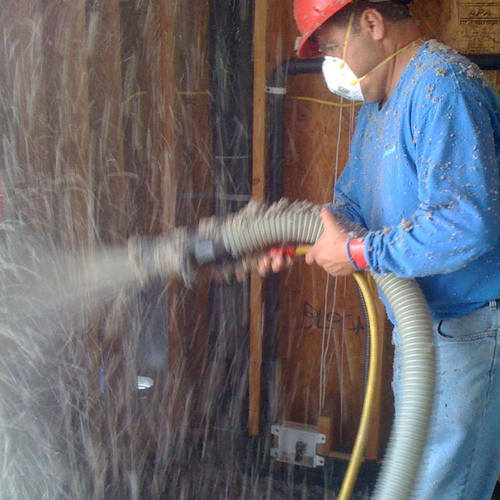
I was amused, and maybe a little surprised, to find a snail mail, printed letter from NAIMA, the North American Insulation Manufacturers Association, in my mailbox recently. This letter, signed by the executive vice president and general counsel, was in response to my earlier post regarding batt insulation. Here is the text of the letter. Please forgive any errors, as it was scanned and run through an OCR program.
REGULAR MAIL
January 17, 2011
Mr. Carl Seville
Advisor to Green Building Advisor
Seville Consulting
RE: Green Building Advisor Article “Should Batt Insulation Be Outlawed?”
Dear Mr. Seville:
Thank you for your article emphasizing the importance of proper installation of insulation. The North American Insulation Manufacturers Association (“NAIMA”) is aware of many qualified contractors who properly install a variety of insulation products, but NAIMA is an advocate of the importance of proper installation in order to achieve full thermal performance. Indeed. NAIMA’s published literature states: “Carefully read the manufacturer’s directions printed on packaging of batt or roll insulation to be sure the material is correctly installed.” In another NAIMA publication, it is stated that “[t]he performance of any insulation product is dependent not only on selecting the proper product but also on installing it correctly.” NAIMA also provides guidance and training materials to insulation contractors.
What is true of all insulation products is that when properly installed, insulation delivers significant energy savings. What is also true of all insulation products is that all can be improperly installed. All insulation products must be installed correctly in order to achieve the intended thermal performance. The National Association of Home Builders (“NAHB”) has stated that “you can choose the right insulation, but it will not do the job it’s supposed to do if it is not installed properly.” The NAHB’s statement is directed towards all types of insulation products: batt and blanket, loose-fill, rigid board insulation, spray foam insulation, and others. Therefore, to single out fiber glass batts is unfair and inaccurate. If there is a problem with batts, there is a problem with all batts, including cotton, plastic, denim, rock wool, slag wool, or any other type of batt. Moreover, the rate of improperly installed fiber glass batts must also be weighed in balance with the fact that fiber glass is the most widely used insulation product in North America. Put simply, more fiber glass batts are installed so more are likely to be improperly installed.
Many insulation products when incorrectly installed not only fail to deliver their optimum thermal performance, but may cause serious damage or destruction to the building too. Just consider a few of the following examples that effectively illustrate the need to apply equitably the phrase “when properly installed.”
In your article, you mention that blown-in products might have been a preferable alternative, though more expensive. As noted above, there is not an insulation product, or any other product for that matter, that is foolproof. Spray foam insulation, which must be installed by experts, can be over-sprayed or under-sprayed. For example, a Maryland inspector reported about an insulation contractor who completely foamed all the walls, roof sheathing, ridge vents, attic fan, and soffit vents. The fan and vents ceased to function. In addition, significant fire and explosion hazards exist during installation of spray foam products. The Occupational Safety and Health Administration (“OSHA”) has identified several fatalities and incidents due to severe asthmatic attacks and fire/explosions associated with the use of isocyanurate-containing materials (which is one of the chemical hazards in spray foam products).
Other examples of misapplication of spray foam include under-spraying that leaves gaps and holes similar to those described in your article on fiber glass batts. These gaps or voids will result in decreased R-value. If during a retrofit foam insulation is applied over a 48 inch space using only a two or three inch opening at one side, the foam will begin to expand and cure before it has reached the full depth of the cavity. This would block any more foam from filling the cavity, so random voids would result. Even proponents of foam insulation caution that “spray foam products must still be sprayed correctly.”
Most other blown-in products can also be under-sprayed, fluffed, or subject to settling. For example, cellulose insulation settles over time. Third party documentation estimates that settling of cellulose insulation shows an average settling value of 19 percent. Therefore, if cellulose insulation is improperly installed without accounting for settling, cellulose insulation will lose about 19 percent of its R-value when it settles. Therefore, proper installation of cellulose insulation is required in order to improve energy efficiency. The installer must take into account installed thickness and settled thickness, which means additional product must be added to compensate for that settling factor.
Too much cellulose insulation above ceilings, however, can impact the ceiling structure of the home. Based on US Gypsum weight limit recommendations for backloaded standard drywall and the installed density of shredded newspaper insulations, there is potential for ceiling drywall to sag at R-values above R-30 for regular cellulose insulation when installed over 1/2 inch ceiling drywall with framing spaced 24 inches on centers. Cellulose insulation, if improperly installed, can cause fires when the insulation is placed near a heat source. In fact, the Consumer Product Safety Commission (“CPSC”) regulates cellulose insulation as a recognized fire threat. To protect against that fire threat, CPSC regulations mandate the proper installation of cellulose insulation: “Based on available fire incident information, engineering analysis of the probable fire scenarios, and laboratory tests, the Consumer Product Safety Commission has determined that fire may occur where cellulose insulation is improperly installed too close to the sides or over the top of recessed electrical light fixtures, or installed too close to the exhaust flues from heat producing devices or apparatus such as furnaces, water heaters, and space heaters. These fires may result in serious injuries or deaths. Presently available information indicates that fires may occur where cellulose insulation is improperly installed even though the cellulose insulation complies with the Commission’s amended interim standard for cellulose insulation.”‘
CPSC has actually issued regulations that mandate proper installation to avoid house fires, yet even a legal mandate cannot stop improper installation as attested to in the enclosed article, “Going Green May Make You See Red.” Improper installation of cellulose is so serious that this warning label must be affixed: Manufacturers of cellulose insulation shall label all containers of cellulose insulation with the following statement, using capital letters as indicated:
CAUTION
Potential Fire Hazard: Keep cellulose insulation at least three inches away from the sides of recessed light fixtures. Do not place insulation over such fixtures so as to entrap heat. Also keep this insulation away from exhaust flues of furnaces, water heaters, space heaters. or other heat-producing devices. To be sure that insulation is kept away from light fixtures and flues, use a barrier to permanently maintain clearance around these areas. Check with local building or fire officials for guidance on installation and barrier requirements. Request to Installer: Remove this label and give it to the consumer at completion of job.
Reflective insulation must be positioned adjacent to an air gap to be effective; otherwise heat will simply conduct through to the next solid layer that it touches. In other words, if the reflective insulation is positioned improperly, it will not deliver the intended thermal performance.
If you are so anxious to outlaw insulation products, would it not be prudent to start with those products clearly identified as threats to life and safety? Certainly outlawing fiberglass batts should be a low priority. Perhaps in future columns you can join with NAIMA and many other insulation producers in advocating proper installation for all insulation products. To single out fiber glass actually does a great disservice to your readers because it suggests that it is somehow a unique issue to fiber glass when, in reality, it is an issue for the entire insulation industry.
Sincerely,
Executive Vice President, General Counsel
North American Insulation Manufacturers Association
So who is NAIMA anyway?
According to its website, “NAIMA is recognized as the voice of the insulation industry for architects and builders; design, process and maintenance engineers; contractors; code groups and standards organizations; government agencies; public interest, energy and environmental groups; and homeowners. NAIMA is an authoritative resource on energy-efficiency, sustainable performance, and the application and safety of fiberglass, rock wool and slag wool insulation products.”
OK, so we know they represent all insulation manufacturers, EXCEPT cellulose, foam, cotton, wool, and maybe a few others I am not aware of. So, it is not surprising that the letter focused on the dangers of spray foam and cellulose insulation while ignoring any potential problems with the products NAIMA represents. I do appreciate that they thanked me for emphasizing the importance of proper installation of insulation products, but I didn’t really need a lecture on how wonderful their products are and how evil the competition is. I suppose what I find the most interesting is that there was no acknowledgment that the title about outlawing batt insulation was tongue-in-cheek and meant only to get the reader’s attention, which it apparently did.
I suspect that NAIMA wishes I had never written the post, and that the whole issue would just go away—but somehow I think that since the letter has inspired me to write about this again, it will have the opposite effect and help promulgate this post even further.
Weekly Newsletter
Get building science and energy efficiency advice, plus special offers, in your inbox.















21 Comments
Clever correspondence strategy
It's interesting that they sent it to you via snail mail. I supposed they hoped that the modest difficulty in digitizing their correspondence would dissuade you from posting it.
Never underestimate the efforts some will go through to positively spin things there way.
Andrew
Insulation Installations
I agree with Mr. NAIMA EO, that is mostly about installation; however in my experience over 15 years of exclusively designing and building high performing houses, 99% of blown cellulose & fiberglass and foam jobs have been installed without a glitch and homes performed as designed, while a very high percentage of the batts insulated homes do not performed as designed, mainly due to poor installation. Perception can be seen as reality, but reality is always reality. That is why I never spec batts insulation.
Forgot to mention..
I got so carried away getting the letter into this post that I forgot to point out how humorless this guy is. It appears that he actually took my comment about banning batt insulation seriously.
He wrote: "If you are so anxious to outlaw insulation products...". I guess NAIMA doesn't do satire very well.
maybe because
Armando Cobo said:
"blown cellulose & fiberglass and foam jobs have been installed without a glitch and homes performed as designed, while a very high percentage of the batts insulated homes do not performed as designed, mainly due to poor installation."
Maybe because insulation that is blown has a higher likelihood of being installed by guys who have a clue, while the batts get installed in volume-built houses by whatever day laborer happens to be standing around in front of Home Depot.
Of course I don't have a study, but ....
Thanks Carl
Vader would be disappointed
I fell asleep twice trying to finish that letter, always expecting to come across some thinly veiled threat like, "I find your lack of faith…disturbing". Nothing. This is hardly threatening. It's just a industry advocate trying to convey their position.
You are a lucky guy
AJ, you are fortunate that you can get batt insulation installed properly. I have rarely seen it done right, it's too frequently the low bid and they just jam it in place and run. Practically every job I have inspected for certification in the last few years has needed to have most if not all of the batt insulation reworked or replaced, it has been installed so poorly.
I have to stick up for workmen
My experience for three decades has been the exact opposite. All of my insulation subcontracted work was installed incredibly responsibly and with great care by hard working sweating men. Really. I think my batt install men were more expert at what they did than my spray foam guys. And I like my spray foam guys.
The problem with fiberglass is air flow through it however and wherever it is installed. Zip wall and pink panther's new sealing spray will make batts work much better I suspect.
Carl, great post
I see your post Carl and will add that I am almost always onsite. Work is done to my acceptance or it is not done or stopped and redone including my own errors of which I have had my share of.
inspected horrible work
I actually just inspected a house that had some renovations done and the installation of the batts in the attic was so poorly done, it amazed me. First there the vapor retarder was on the wrong side, improper fit, and pieces just thrown on top to cover any holes. A blown in product would have done a much better job and easier to install.
The buck stops with the buyer and seller not the trades person
The race to build castles for the incomes available sets the standard of batt installation. Nothing else. (That is when you see poor workmanship) The dollars are ruling in these situations not caring.
But still, a caring customer hiring a caring contractor will get batts installed, with care, by a caring crew or sub.
Same with the other 35 trade specialties.
AJ--I agree that is the
AJ--I agree that is the Builder's responsibility to make sure the trades aren't running the job. But very few insulators do batt insulation correctly--cutting around boxes, wires, non-standard cavities. Batt insulation is the most difficult insulation to do right. It's all about the fit and finish.
Insulating the future
I bet the death star was not insulated using Batts!
Clueless inspector?
quote: Spray foam insulation, which must be installed by experts, can be over-sprayed or under-sprayed. For example, a Maryland inspector reported about an insulation contractor who completely foamed all the walls, roof sheathing, ridge vents, attic fan, and soffit vents. The fan and vents ceased to function.
That is why its called an unvented attic. Maybe the inspector should have read up on it.
John Zito
Nobody works with me anymore doing one motion that I disapprove of. That simple. I have never had batts installed poorly. We debated poor batt installation decades ago, and back then got the info as to proper install. That was it for me. After that, the gents walk on the job, put up a piece. They do it right and keep going. They do it wrong and all stops. I no longer train subs or workers. I work with those that are better at their trade than I am or they don't work with me. I am not the type that is able to teach others on my dime. I just have never been able to do so. One of my flaws that I now know how to work around for alls benefit.
You can find contractors that are great. But you have to be willing to go the distance to find them. Once found, respect, pay timely and buy lunch once a week. And stay on a schedule that is mutual to both of you. Do not abuse them and then you can expect the same back.
I don't use subs for all the trades, but the ones I do are A+ in skill and character.
Blown insulation
Unfortunately most blown jobs can not be inspected after they are finished. They ALL settle, also most of the time areas are missed. As a remodeler I open up the old walls and find 3-4" at the top of all walls with no insulation. The best was a house that I was running a new circut to an outlet in the kitchen. The wall had an insulation conduit all the way up to the box, a 2" wide by 4' high void with NO insulation, most likely all through the house, even the poorest batt installer does better than that. Blown ceiling maybe blown walls your kidding your self!
Looks like there's a bunch of
Looks like there's a bunch of DC lobbyists at that address, no wonder the "outlaw" quip sent up legislative alarm bells
What are your thoughts on the
What are your thoughts on the "Flash and batt" method? Also, we once had a contractor try to sell us on using double layers of 2x4 (R13) batts in a 2x6 wall. Your thoughts? I couldn't agree more with AJ, with regards to where responsibility lays. i would love to build nothing but high performance super insulated homes, but there's no one in this area that would pay for it. It seems, at least in this area, that there's a perception that building homes is easy and it shouldn't cost much. its a never ending battle it seems around here.
Aaron, doubling up works, see posts above
Aaron, the one thing you can do to make a home much more energy efficient is to either glue your whole frame together layer after layer, or for not that much, about $1.00/sqft get your frame professionally sealed.
http://www.ocenergycomplete.com/system/ (A note about Owns Corning, the pressure is on them to go green. They have changed their fiberglass to be formaldehyde free and they are advertising 30% post consumer content)
Greener company possibly; (no pink panther dye at least)
http://ecoseal.knaufinsulation.us/
Just sealing a home to a very good ACH could lower the energy use of one of your builds by almost half. Yes, you do need to site the home at it's best too, among a few other points.
Fiberglass batts need the space they are installed in sealed well on all six sides.
Where are you located Aaron?
Carl, I love the Darth Vader pic, perfect though wish we pushed big pink to do better after the first energy crisis in the 70's.
Insulation is Insulation, Right? Wrong
I, like you, hate professionally installed batt insulation. I like it well enough in certain applications when I'm in complete control of the job quality assurance. The factory you visited is in my backyard. I have no complaint about the manufacturer. I prefer their products.
What hasn't been pointed out is that because the insulation is batts, it's hard to get right when the framers screw up their job. BPI derates batt insulated walls for very good reasons! Simply put, just because it says R-13 on the insulation doesn't mean its effectively R-4 (or less). At least when cavities are filled with blown stuff, they get a higher effective value because the entire cavity is filled!
Our school has a house we're proud of with batts because it out performs houses with foam and blown insulation. The contractor guarantees energy bills and has never had to pay up!
The moral is that the builder needs to know what a quality job looks like and put in QA practices to ensure it--whatever the type insulation installed!
wouldn't it be easier
AJ, wouldn't it be easier to install a product such as Grace vycor enV? Assuming usual sealing practice for penetrations, plates, etc... FWIW I'm located in SW Michigan, Zone 5
Aaron
No
Sam's Batt house
Sam, I'd like to hear more about your "house...with batts..out performs...foam..blown." Can you share more information on this? Do you have any tests to base the result on? I heard a similar account from another designer/builder recently have not been able to find any substantiating tests/reports.
Log in or create an account to post a comment.
Sign up Log in